
James River Distillery
by
Terry Sullivan
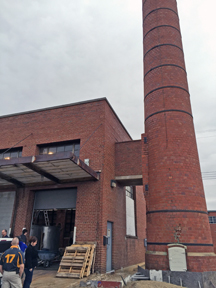 Summary: Dwight Chew is the passionate, energetic distiller at the Richmond based James River Distillery. The distillery has a home in a brick building that was once a boiler building for the surrounding buildings.
Summary: Dwight Chew is the passionate, energetic distiller at the Richmond based James River Distillery. The distillery has a home in a brick building that was once a boiler building for the surrounding buildings.
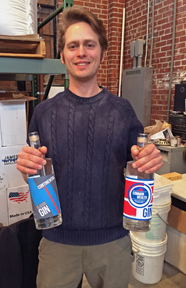 After the distilling session at the Craft Beverages Unlimited trade show and conference in Richmond, we took a short bus ride to James River Distillery. The brick building has a very tall chimney next to it, a testament to a former use as a boiler building. Distiller, Dwight Chew is creative. During the summer without air conditioning, he opens a flue leading into the chimney. That helps circulate the air in the distillery, a welcome relief to high summer temperatures and humidity. Before becoming the James River Distillery, the building was a vodka distillery.
After the distilling session at the Craft Beverages Unlimited trade show and conference in Richmond, we took a short bus ride to James River Distillery. The brick building has a very tall chimney next to it, a testament to a former use as a boiler building. Distiller, Dwight Chew is creative. During the summer without air conditioning, he opens a flue leading into the chimney. That helps circulate the air in the distillery, a welcome relief to high summer temperatures and humidity. Before becoming the James River Distillery, the building was a vodka distillery.
Dwight made many changes to the still, rebuilding parts and adding other parts. The space in the building is compact, but every inch is well used. For example, the hammer mill creates a lot of dust when it is operating. The entire building would be covered in dust if not for a simple closure made from pvc tubing and a covering. While not in use, the plastic enclosure is tucked away in a corner where it takes up very little space.
Dwight is a self-taught distiller. His background includes running an organic farm. He made pickles and followed his interest in fermentation by making beer and wine. For a while, Dwight worked at a brewery. The James River Distillery opened in late 2014 and Dwight feels at home.
Gin
Currently the distillery is producing gin. Dwight starts with 2,000 pounds of corn and runs it through the hammermill. The milled corn then goes to a cooker where it is heated. The heat starts to break down the starches. At this point the consistency of the corn reminds Dwight of polenta. About 10% of the mixture is barley malt. The barley malt contains enzymes that are needed to convert starches to sugars. The mixture is then pumped to a fermenter and fermented for several days. After fermentation the mixture is about 9.5% alcohol.
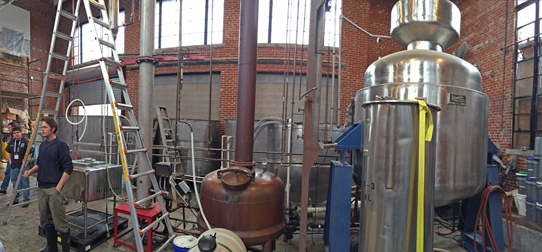
With the starches converted to sugars and the sugars fermented to alcohol, the mixture is transferred to a large stainless steel stripping still and the distilling process begins. This first still strips off the alcohol. About 500 gallons are produced. The alcohol is then transferred to a copper still where it is distilled to 160 proof. A second pass through the copper still is used to remove the heads, hearts and tails. The hearts are used to produce spirits. The hearts may be distilled again. Dwight wants to create a neutral spirit.
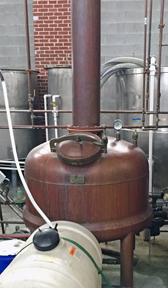
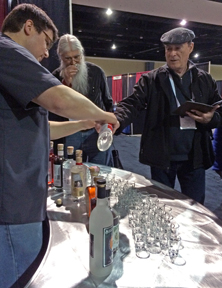 The alcohol is then transferred to a column still. A vapor basket filled with botanicals is attached to the column still. As the alcohol vaporizes it passes through the vapor basket. The botanicals give the gin its taste. The final strength of the alcohol is about 183 proof. The alcohol is then cut with water to lower the alcohol. The gin is then bottled.
The alcohol is then transferred to a column still. A vapor basket filled with botanicals is attached to the column still. As the alcohol vaporizes it passes through the vapor basket. The botanicals give the gin its taste. The final strength of the alcohol is about 183 proof. The alcohol is then cut with water to lower the alcohol. The gin is then bottled.
Back at the conference we tasted one of James River Distillery’s gins. Commonwealth Gin was crystal clear. It had a floral and juniper aroma. It was very smooth with a long floral and herbal aftertaste. The gin was 40% alcohol.
Dwight’s enthusiasm in describing the distilling process and distillery is certainly contagious. After our visit we were looking forward to tasting his gin.
James River Distillery
2700 Hardy Street
Richmond, Virginia 23220
Article written March 2015
Visit these distilleries that advertise with Distilling - Wine Trail Traveler.
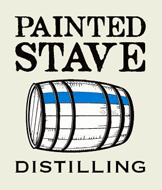 |
 |
|
| Painted Stave | Pinch Gut Hollow Distillery |
